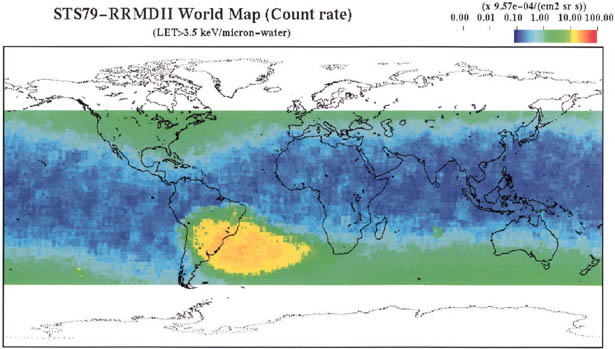|
|||||

|
 |
| Outline of the Mission |
National Space Development Agency of Japan (NASDA) has performed
Space Radiation Environment Measurement Experiment in September 1996. Real
time Radiation Monitoring Device (RRMD) on board the Space Shuttle Atlantis
(STS-79) which was launched on September 16 was used and the experiment was
terminated on 26 September. This experiment was planned for the purpose of
applying its results for planning the measures used to avoid the effect of
space radiation in the International Space Station (ISS) by monitoring the
space radiation environment under similar orbital environment as the ISS.
Shuttle/Mir mission is being promoted as the first step of the International
Space Station (ISS) with the primary effort by USA and Russia. The purpose
of this mission is to mitigate the technical risks of constructing and operating
the ISS prior to the actual activities by checking technical issues, extracting
problems and accumulating international space activities experiences. Shuttle/Mir
mission activities include docking Space Shuttle with Russian Space Station
Mir and to navigate cooperatively each other, transferring crew and supplying
goods from Shuttle, performing extravehicular activities (EVA) by astronauts
from both countries and promoting scientific researches which are inevitable
prior to the utilization activities of the ISS.
From 1995 through 1998 nine missions have been assigned for Shuttle/Mir mission,
and STS-79 is the one of them.
| Orbiter | Atlantis (17th flight) |
| Launch date and time | September 16 1996 4:54 a.m. (EDT) |
| Launch site | NASA Kennedy Space Center |
| Initial orbital altitude | 300km |
| Orbital inclination | 51.6 degrees |
| Orbital period | 90 min |
| Mission duration | 10days 3hr 19min |
| Landing date and time | September 26 1996 8:13 a.m. (EDT) |
| Landing site | NASA Kennedy Space Center |
| Major Accomplishments of STS-79 |
Space radiation measurement was conducted by RRMD aboard STS-79
on the scheduled orbit of the International Space Station. Of radiation particles,
those which are heavier than carbon were selected as objects of priority measurement
of radiation doses. As a result, it was found that the absorbed dose rate
in the South Atlantic Anomaly (SAA) zone is far much more higher than those
in other zones, and that the incidence of high-energy space radiation increases
at the time of passage above the polar proximity zone. An experiment was also
conducted on the biological effect by space radiation using such specimens
as colitis germs and genetic DNA. The finding of this experiment reconfirmed
the experiment result obtained on the FMPT mission to the effect that a specific
ferment activator is required for repair of DNA damages by space radiation.

Last Updated : March 27, 1998

|